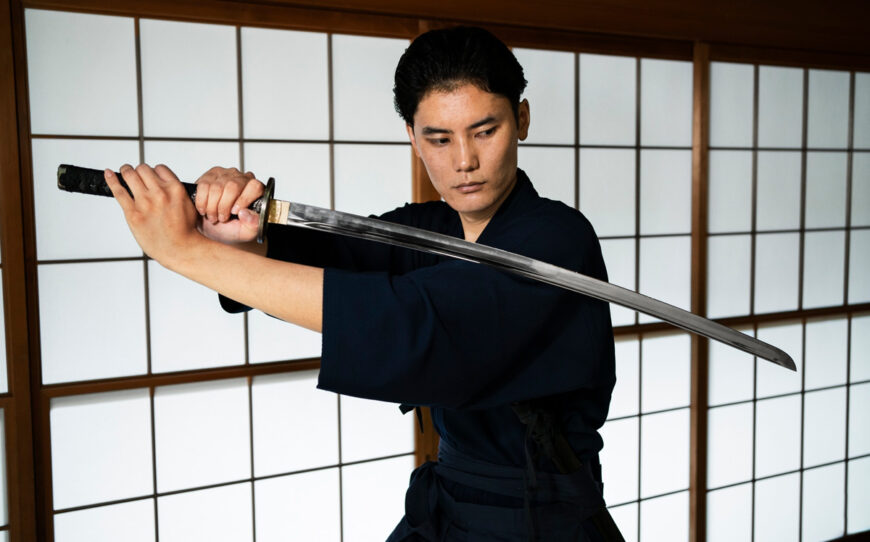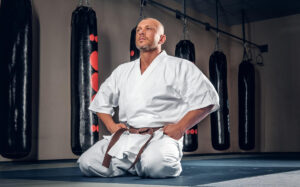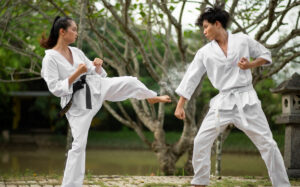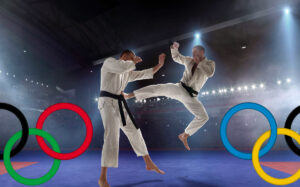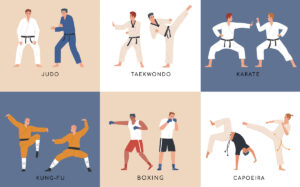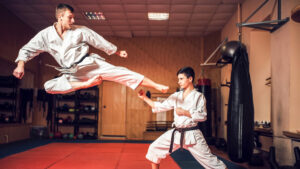Do you want to enhance your self-defense skills with traditional martial arts techniques? Believe it or not, numerous martial arts styles incorporate weapon usage into their training routines.
This blog will give you an in-depth look at the world of weapon based martial arts, helping sharpen your knowledge base and skill set. Don’t miss out – join us on this fascinating journey into combat history and technique!
Key Takeaways
- Weapon based martial arts use tools in their fight styles like swords, sticks or fans.
- Many countries have their own type of weapon – based martial art. Examples include Arnis from the Philippines and Gatka from India.
- These sports help people grow strong, fast, good at aim and able to think quick on their feet.
- People learn about history, culture and self – defense by practicing these fight styles.
Popular Weapon Based Martial Arts Styles
Several unique styles exist within the framework of weapon-based martial arts, such as Arnis, Bōjutsu, Canne de combat and Gatka. Gungsul and Geom sul showcase dynamic techniques with traditional Korean weapons.
Hanbōjutsu invites practitioners to master three-foot staff fighting while Kendo offers a chance for swordsmanship refinement. Jōjutsu involves combative stick-fighting training whereas Siljun Dobup focuses solely on drawing and sheathing swords swiftly.
Other essential disciplines include Mau rākau which incorporates wooden weapons of Maori warriors and Zulu stick-fighting known for lethal attacks using short sticks.
Arnis
Weapons used: stick, knife, other bladed weapons.
People also call it Eskrima, and many think this is one of the best styles that use weapons in its training. So, if you want to use a tool as part of your self-defense, Arnis might be a good pick for you!
Bōjutsu
Weapons used: bō.
You also learn about close-quarters combat with it.
Practice makes perfect in Bōjutsu. It takes time and effort to master the moves of this martial art style. So, if you practice hard, you will become better at speed, agility, and precision in fights.
Canne de combat
Canne de combat is a fun martial art style from France. It teaches how to fight with a cane or stick. The moves are very fast and need much skill. Canne de combat is like fencing, but it uses a stick instead of a sword.
You must think quick in this sport, as it needs good aim and timing for attacks and blocks. This game helps make your body strong too because you use many muscles during play.
Fencing
Fencing is a top weapon-based martial art. It uses swords in the fight. With roots in Spain, it came to life around the 15th century. Players use thin, light swords named foils, sabres or epees based on their style of fighting.
Fencers aim to touch foes with their sword while staying safe themselves. They wear safety gear like masks and jackets always. This sport tests quick thinking and speed more than any other mainline sport!
Hanbōjutsu
Weapons used: hanbō.
With this weapon, you can block hits, hit back and even trip your foe! It trains you to have quick eyes and firm hands. You also get the added bonus of learning ancient fighting techniques of the Samurai class.
Gatka
Weapons used: stick.
Though people may see it as dancing, it’s really about self-defense skills.
Gungsul
Weapons used: Korean horn bow.
This art helps in self-defense.
It does not stop at selfdefense techniques though, it also builds mental strength and focus. Anyone can start learning Gungsul – age or fitness level doesn’t matter much here! Just a bit of time every day can take you from novice to pro in this ancient fighting technique.
So get on the path of being a warrior with Gungsul!
Geom sul
Weapons used: Korean sword.
Geom sul is a kind of Korean martial art. It uses a sword for fighting. Many people learn this skill to keep safe or for fun. You can find Geom sul in many parts of the world today.
This self-defense method has a deep link to Korean culture and history too!
Iaidō and iaijutsu
Weapons used: sword.
Iaidō and iaijutsu fall under unique martial arts styles from Japan. Iaidō is the art of quick-draw sword fighting. It calls for great skill and focus to pull out the sword, slice at an enemy, wipe off the blade, and re-sheath it in a single swift move.
Iaijutsu is like a sister practice but with more forceful cuts and stabs using older combat methods. These two forms teach practitioners not just about weapon handling skills but also about discipline and control over their minds as well as hearts during battle times.
Training involves practicing forms again and again for one to achieve speed, agility, precision along with understanding defense tactics effectively.
Jōjutsu
Weapons used: jō.
It also teaches defense moves against swords or other weapons.
In Jōjutsu, every part of the stick has a purpose in fighting. Both ends can hit or trap an enemy’s weapon. The middle part stops sword cuts and also strikes back at foes. Practicing Jōjutsu needs both skill and sharp thought!
Kendo (and jūkendō)
Weapons used: shinai, bayonet.
Kendo is a martial art from Japan. It uses swords made of bamboo. Players wear armor to stay safe while they spar. The goal of Kendo is to hit your opponent with swift, exact moves.
Jūkendō is like Kendo but it uses wooden rifles instead of swords. Both arts teach good focus and self-control skills.
Kobudō
Weapons used: blades, firearms.
Krabi-krabong
Weapons used: sword, staff, club, stick.
Krabi-krabong comes from Thailand. It uses weapons in combat. The main tools are Krabi and Krabong, a sword and staff. Fighters also learn to use other things like axes or spears. They do not only spar with swords or sticks though, they train their body to fight as well.
This way if the weapon is lost, they can continue the battle. This art holds Thai history and traditions together with self-defense skills.
Kyūdō
Weapons used: bow.
Kyūdō is a form of martial arts from Japan. It uses a bow and arrow. This art style goes back many years. It mixes Zen teaching with the skill of using a bow and arrow.
In Kyūdō, you must stand very still. Your mind must be clear too. You pull the bow and let go when it feels right, not because you aim to hit something! A lot of practice makes a good Kyūdō artist.
Some say it’s more about the person than the weapon they use.
Mau rākau
Weapons used: staffs, canes, blades, clubs.
Mau rākau is a martial art from New Zealand. It uses long, wooden sticks for combat. This fighting style started with the Maori tribe. They used it to protect their land and people.
You will get strong and quick by practicing Mau rākau. This art also teaches you respect and honor for your culture and others around you.
Naginatajutsu
Weapons used: naginata.
Naginatajutsu (長刀術 or 薙刀術) is a martial art from Japan. It uses the naginata, a long pole with a curved blade at the end. Naginatajutsu comes from the time when samurai ruled Japan. Many women learned this art to protect their homes and families.
This martial art puts focus on footwork and strikes from afar. The goal isn’t to fight up close but to hit foes before they come near you due its weapon’s long reach aspect.
Nunchaku-do
Weapons used: nunchaku.
Nunchaku-do is a style of martial arts. It makes use of nunchaku, a weapon with two sticks linked by a chain or cord. This art comes from Okinawa, Japan. It centers on swift and skilled moves to hit and defend against hits.
Training in Nunchaku-do gives better speed, agility, and focus. Though seen as rare today, it continues to captivate many with its unique blend of force and grace.
Shintaido
Weapons used: bō.
Shintaido helps people make their bodies strong. They use wide moves like waves or wind in nature to warm up the body and be ready for action. Next come pair work or group study using shouts for energy release.
In Shintaido, every person can find his own way to move free and safe at all times.
Silambam
Weapons used: staffs, blades, swords, sickles, canes, knifes, etc.
Silambam is a martial art style from India. People use long bamboo sticks in this type of fighting. They swing and twirl the stick fast to hit or block attacks. This art helps build strength, speed and focus.
It also teaches footwork skills needed for close fights. Some forms of Silambam have sword or fire staff moves too. Many people enjoy learning this strong yet graceful fighting style today.
Siljun Dobup
Weapons used: sword.
Siljun Dobup is a Korean art form. It uses sharp swords in a safe way. In this style, the sword moves quickly and suddenly from its case to attack or defend. It needs good mind control and body balance.
Skills build up with practice over time. This martial art gives you power, speed, and self-control. You can learn Siljun Dobup at many places around the world.
Singlestick
Weapons used: singlestick.
Singlestick is a type of martial arts. It comes from Europe. In this sport, you use a wooden stick as your weapon. You aim to hit the head of your opponent to win points. The stick acts like a sword in this sport but it does not hurt as much when you get hit by it, because it’s made from wood! To keep them safe, fighters wear special hats and jackets while playing.
Sōjutsu
Weapons used: yari.
Due to its reach and speed, warriors found this weapon hard to beat on the battlefield. Training also helps keep your mind sharp, like a spear point! While not as known today, Sōjutsu teaches valuable skills in balance and strategy.
Tahtib
Weapons used: stick.
Tahtib (Egyptian Arabic: تحطيب taḥṭīb) is an art from Egypt. People use a long stick to fight in it. Men and women both like this art. They dance with the moves too! Some people have kept this style as-is for a very long time, but others added new moves with kicks.
Schools now show Tahtib often at parties or shows for fun and tradition.
Taiho jutsu
Weapons used: sword, staff.
Tessenjutsu
Weapons used: tessen.
Even when they could not carry other weapons, they had their fans with them. The tessen can be made of hard wood or metal plates. When folded, it looks normal but can hit quite hard! In Tessenjutsu practice today, people learn how to use speed and surprise to get an upper hand in fights using this hidden weapon.
Zulu stick-fighting
Weapons used: stick.
Stick fighting takes skill, speed and good aim. The thick end of the fight-stick hits the opponent while the thin side helps block hits. It’s more than just a sport – it can also teach lessons about life.
Overview of Weapon Based Martial Arts
Weapon-based martial arts encompass a wide spectrum of combat techniques that entail the use of one or multiple weapons. These fighting systems trace their roots back to various parts of the world, each with its unique history and evolution over time.
Weapons utilized in these martial arts range from swords, staves, nunchaku, bows to knives and more unconventional tools like chain whips or fans. Far from being relics of bygone eras, weapon-oriented training continues to hold crucial relevance in contemporary martial arts practices around the globe as it not only enhances self-defense capabilities but also hones agility and focus.
Beyond practical applications in modern defense scenarios, these art forms preserve cultural heritages and promote physical fitness alongside mental discipline.
Definition and history
Weapon Based Martial Arts started long ago. It is a way of fighting that uses tools or items in your hands. Many cultures around the world have their own forms of this art. For example, in Japan, they use swords for martial arts like Kenjutsu and Kendo.
In South Africa, Zulu Stick Fighting is popular which makes use of sticks for combat. These areas built these skills to protect against danger or fight on wars during ancient times.
Now people learn them as a form of sport and self-defense.
Importance of weapon training in martial arts
Weapon training in martial arts is vital. You will learn to handle different tools for self-defense. For some styles like Kenjutsu, the sword is the major focus. Others such as Eskrima and Kobudo use various weapons during training.
Weapon training can boost your speed, power, and sense of distance in a fight. It adds more skills to your hand-to-hand combat know-how too. This training also offers good safety lessons on correct weapon usage outside the dojo or gym.
Different types of weapons used
In weapon-based martial arts, there are many types of weapons. They depend on the martial art.
- Sticks and Staffs: They are used in Eskrima and Zulu Stick Fighting. The long or short staff is a basic weapon.
- Swords: In Kenjutsu and Kendo, swords help train. The styles focus on sword skills.
- Various Weapons: Kobudo uses different kinds such as staffs, sickles, and spears.
- Spears: Some martial arts also use spears, but they are not well-known.
- Nunchaku: This is two sticks linked by a chain or rope used in Nunchaku Do.
- Blades: Martial art styles like Siljun Dobup use blades for combat training.
- Archery tools: In Kyūdō, archers learn how to shoot arrows.
Benefits of Weapon Based Martial Arts
Training in weapon based martial arts offers both physical and mental benefits, including improved fitness, better coordination, and sharpened focus. This form of martial arts provides practical self-defense skills by teaching effective usage of various weapons.
One also gets to explore the cultural values embedded within different traditional combat styles during training.
Improved physical fitness and coordination
Doing weapon based martial arts helps your body get better. It makes you strong and fit. You learn to move in new ways. Fast moves help make your muscles work hard. This can give you a good workout.
With these arts, the right and left sides of your body must match up well. The sword or stick is to be held tight but not too much! Tentative holds on weapons might cause mistakes during an attack or block.
As a result, having firm grips shows how good one’s physical power has become over time from training in martial disciplines like Kenjutsu or Kobudo (from facts 1 and 3). For spear-based ones (from fact 9), it takes even higher level skills of balance and motion control for nailing correct stances while wielding long spears single-handedly.
These poses also build strength in core areas, arms and legs alike! With each step ahead, pupils will start feeling more ready to take on bigger challenges that require greater fitness along with improved hand-eye sync-ups for perfecting defense-and-attack rhythm patterns.
Effective self-defense and personal safety skills
Weapon based martial arts teach you to stay safe. These skills can save your life in danger. You learn to use tools like swords or sticks. Zulu Stick Fighting and Eskrima are two styles that use these tools.
You do not only guard yourself from hits but also fight back when needed. The goal is not to hurt others, but it’s about safeguarding oneself wisely. Over time, training makes you better at quick moves and swift thinking.
Your brain learns to make smart choices during threats.
Enhanced mental discipline and focus
Weapon based martial arts can boost your brain power. Training in these sports takes more than just muscle, it needs a strong mind too. It’s like sharpening your mind as you would a sword or a stick.
You learn to think fast and stay focused.
In weapon based martial arts, every move counts. If your mind wanders, you could get hurt. So you have to pay close attention at all times. This kind of focus helps improve mental discipline not just on the mat but off it too!
Cultivation of traditional and cultural values
Weapon Based Martial Arts are rich in traditional and cultural values. They come from old times. Each art form passed down from one generation to the next. For example, Eskrima is a Filipino martial art with a deep history.
Kobudo comes from Japan and brings its own cultural marks. Zulu Stick Fighting has roots in South Africa’s warrior traditions like tribal wars and lion hunting rituals. All these arts teach respect for their origins besides fighting skills.
Training in these arts means learning about the culture they come from too.
Training and Techniques in Weapon Based Martial Arts
Training in weapon-based martial arts requires learning proper handling and techniques for the chosen weapon. These martial arts emphasize precise forms, often mimicking real combat situations with sparring drills.
Speed, agility, and precision are honed through continuous practice sessions. A unique feature of these training programs is their integration of weapon techniques alongside unarmed combat skills to provide a comprehensive self-defense curriculum.
The careful coordination needed for effective weapon use deepens the student’s understanding of movement dynamics, leading to improved overall physical control. Developing skill in weapons also imbues respect for traditional combat weaponry and highlights their significance beyond mere tools of aggression or defense.
Learning proper weapon handling and techniques
You need to know the right way to hold and use a weapon in martial arts.
- Use your hands right. The grip on your weapon should be firm but relaxed.
- Know your weapon. Each tool has its own properties like weight, size, and balance.
- Safety first! Always guard yourself and others when using weapons.
- Learn from professionals. A good teacher can show you the best way to use your weapon.
- Practice makes perfect. Train often to gain skill with your chosen weapon.
- Respect the weapon as an extension of your body.
- Kenjutsu teaches the Japanese way of sword fighting.
- Kobudo uses many different weapons so there’s always a new tool to master.
- Zulu Stick Fighting is all about handling sticks in combat.
- Eskrima from Philippines shows how to fight with swords too.
- Kendo of Japan gives you lessons on handling a bamboo sword safely in mock battles.
- Spear – based martial arts are rare but they are worth searching for due to their unique techniques.
Practicing forms and sparring drills
Practicing forms and sparring drills help in mastering weapon-based martial arts.
- Practice the Kenjutsu style with focus on sword techniques.
- Learn Eskrima, a top-rated weapon-based martial art from the Philippines.
- Take part in Zulu Stick Fighting to improve your stick combat skills.
- Engage in Kendo sessions to better your sword – play.
- Take up spear – based martial arts for something less common, but engaging.
- Explore Kobudo that trains you on using different weapons.
- Try Fencing, another highly ranked discipline in weapon – based martial arts.
- Opt for Siljun Dobup, a marital art based mostly on weapon movements.
- Lastly, do not forget the crucial role of drills like Mau Rakau or Nunchaku Do in perfecting your skills.
Developing speed, agility, and precision
Training in weapon-based martial arts boosts speed, agility, and precision. Fast moves help you attack or defend with weapons. You need to be agile to duck, jump, and run. Exact movements matter most when using swords or spears for example.
Kobudo warriors do a lot of training to swing their weapons right at the last inch! Asian sword fights like Kendo also have drills which help build these skills too. From Eskrima in Philippines to Zulu stick fighting in South Africa, learners all over the world work on becoming quicker, sharper and more precise.
Integrating weapon techniques with unarmed combat skills
Using weapons in martial arts is not just about the tool itself. It teaches how to combine kicks, punches, and other moves without a weapon too. Like Eskrima and Kendo mix sword skills with hand-to-hand action.
This helps build speed, agility, balance, and focus for any fight situation. In Zulu Stick Fighting from South Africa you learn both stick attacks and bare-handed techniques together for full effect in combat.
Training this way leads to better self-defense as it opens up more ways one can win in a conflict or keep safe.
Must Read:
- Top 21 Deadliest Martial Arts In The World According To Experts
- 13 Best Martial Arts For Self-Defense
- Best Martial Arts for Streetfight
- The Wing Chun Dummy: Origins, Features, Types, and More
FAQs
1. What are weapon-based martial arts?
Weapon-based martial arts are fighting systems where weapons like sticks, swords, or knives are used.
2. Can I learn weapon-based martial arts if I’m a beginner?
Yes, beginners can start learning weapon-based martial arts by joining classes that teach basic skills and safety measures.
3. Are there specific weapons tied to different types of martial arts?
Yes, each type of weapon-based martial art usually has a particular weapon associated with it; for example, Kendo uses swords while Arnis focuses on sticks.
4. Is learning weapon-based martial arts dangerous?
If taught well and practiced safely with proper protective gear, risk in learning weapon-based martial arts is greatly reduced.
5. How does training in these disciplines benefit me health wise?
Training in these disciplines aids body strength improvement and boosts mental focus.
Conclusion
Weapon Based Martial Arts teach us a lot. They improve our body and mind. We also learn about history and different cultures from them. So, we should try learning Weapon Based Martial Arts for good health, self-defense, and knowledge too.

